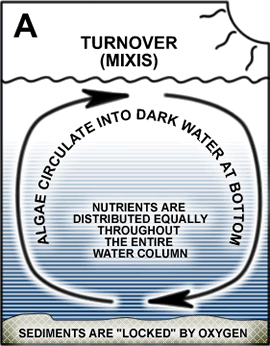Algae, Algae, All Year 'Round!
Lakes behave differently in the winter than in the summer. We’ve already explored some of the physical differences in our Stratification article (Spring 2002 Waterline), now let’s discuss of some of the biological differences between the seasons. Specifically, what happens to the algae and the zooplankton
Turnover
During turnover, the whole water column is approximately the same temperature. The lake “turns over” because the water mixes from top to bottom. Algae are diluted and mixed throughout the entire water column. Because of this mixing, the algae are exposed to sunlight only occasionally (depending upon lake depth and clarity). The available nutrients and oxygen are distributed throughout the entire water column. The sediments release very little phosphorus in the presence of oxygen, so there is no internal loading of phosphorus during turnover.
Diagram of a lake during turnover.
Spring
When the surface heats up enough, the lake will stratify into layers based on water temperature, with the cooler water on the bottom. After the lake stratifies, the algae are no longer mixing to the bottom. The algae in the epilimnion, or top layer of water, are free to grow like gangbusters. This is called the spring bloom.
Lake stratification and the subsequent algae growth are ultimately brought about by increasing water temperatures. As the temperature rises, so does the population of grazers. Zooplankton eat the algae all winter long, but the rate of grazing increases directly with temperature. So the zooplankton grow quickly during this period. Not only do they get bigger, but they reproduce at a much greater rate. The zooplankton young are hungry and will also eat lots of algae. Both adult and juvenile zooplankton have small mouths, so they are restricted to grazing on small algae.
Diagram of a stratified lake.
As organic matter settles out of the epilimnion into the hypolimnion, it decomposes. The decomposition process uses oxygen. Eventually, there will be no oxygen in the hypolimnion and phosphorus will be released from the sediments by a process called internal loading. Stratification not only keeps oxygen from reaching the hypolimnion, it also prevents the phosphorus from reaching the epilimnion (Figure B). Unless there’s a significant amount of rainfall to bring runoff to the lake, the concentration of available nutrients in the epilimnion will start to decline. Meanwhile, the population of grazers is growing rapidly. Before long, the algae will have either run out of nutrients or be eaten by zooplankton and the lake could have its clearest water of the year. This period is known as the clear-water phase.
Of course, during this whole process, the fish aren’t just sitting around on their tailfins. Many species of fish time their mating to take advantage of the abundance of zooplankton.
As the small edible algae become scarcer and newly-hatched young fish begin to feed on zooplankton, the zooplankton population will also crash. After a time, the algae and zooplankton populations will recover and stabilize. There will be more types of algae and zooplankton present in the lake now than during winter. (a more diverse community structure).
Zooplankton on a chlorophyll filter are seen as small clear blobs about the size of a pinhead.
Of course, during this whole process, the fish aren’t just sitting around on their tailfins. Many species of fish time their mating to take advantage of the abundance of zooplankton.
Various species of copepods, a type of zooplankton. As posted on Wikipedia.
As the small edible algae become scarcer and newly-hatched young fish begin to feed on zooplankton, the zooplankton population will also crash. After a time, the algae and zooplankton populations will recover and stabilize. There will be more types of algae and zooplankton present in the lake now than during winter. (a more diverse community structure).
Daphnia magna, a large zooplankton. As posted on Wikipedia.
Summer
Smaller, fast growing algae dominated in the cool waters of spring. As the water warms up, larger species of algae begin to play a more important role in the lake’s ecology. Some types of algae grow in mats or filaments, thus avoiding the pressure of grazing.
Autumn
The young fish that hatched in the spring have gotten much bigger by the end of summer. They can now eat the largest zooplankton, which are the most efficient at filtering the algae out of the water. As the larger zooplankton are removed, algae blooms in autumn are not uncommon.
Eventually, the lake will start to cool and epilimnion will extend deeper into the water column, eroding stratification. As this happens, the phosphorus that was released to the hypolimnion during stratification (see Figure B) will begin to mix into the epilimnion. While that means that nutrient concentrations will be higher in the surface waters, the algae will be diluted and circulated through the dark bottom water, inducing light limitation. Thus, the lake should clear up a bit.
Winter
The typical northern Missouri lake may be covered with ice throughout the winter. Ice covered lakes stratify, but in a different way. For these lakes the warmer water will be on the bottom. In the absence of ice cover, southern Missouri lakes often mix all winter long.
Thanks to the cold temperatures, some algae and zooplankton species will have died off. Others will have gone into “resting stages,” while a few species will still be active. As the waters warm or conditions become otherwise favorable, the eggs or “resting” cells on the bottom will become active and the cycle will begin again.





